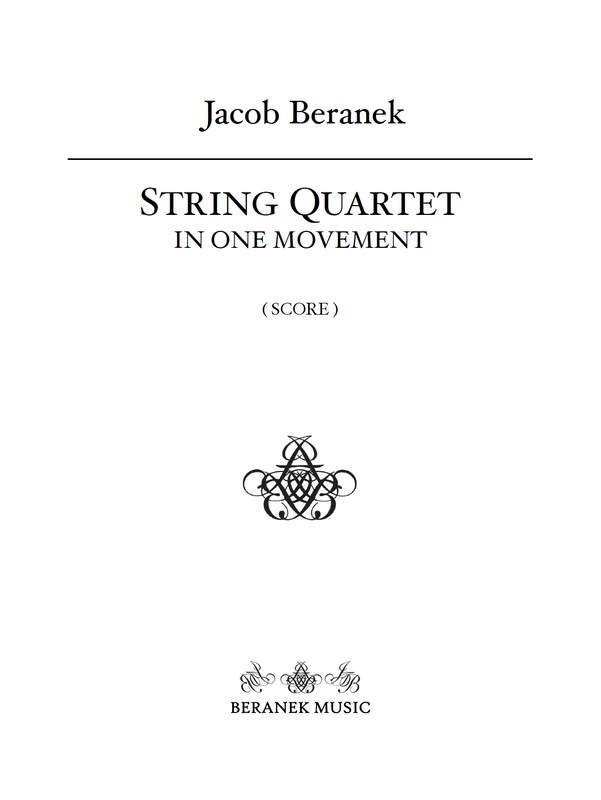String Quartet in One Movement (2020–21)
2 violins, viola, cello
2 violins, viola, cello
Score & Parts (digital download): $25.00
Score Only (digital download): $12.00 Score & Parts (hard copy): $60.00 + shipping Score Only (hard copy): $20.00 + shipping |
PROGRAM NOTE
My grandmother, Avis Weaver Beranek (b. 1940), grew up in the vast North Woods of Wisconsin. Once, as a young girl, she “ran away from home” to her great-aunt’s house (a couple miles away), where Aunt Abby taught her to play the hymn “Jesus Loves Me” in thirds on an old upright piano. This quartet is not supposed to represent this bit of family history, but the story sparked my inspiration for the piece: to hide the tune of “Jesus Loves Me” throughout and gradually reveal it as the composition unfolds.
Lasting just under fifteen minutes, this one-movement quartet pits feelings of peace against anxiety in one broad arch, a cyclical “ ABCB'A' ” form. At the outset, the strains of a distant, celestial chorale emerge with the notes of “Jesus Loves Me” indistinguishably buried in its inner voices. The chorale’s melodic line serves as the main theme of the piece, and a warped, pitch-bending gesture appears, which is motivic throughout the work.
Restless sixteenth notes ignite the next section. The seemingly unrelated scurrying actually outlines the first four notes of “Jesus Loves Me,” before turning back on itself palindromically. After briefly returning to the opening theme, a new landscape emerges, slowed to near-pulselessness. A low, legato song blossoms over the decelerated texture before the music reboots with anxious sixteenth notes once more.
Now, the hysteria consumes itself quickly and completely, burning out in one great, chaotic screech. In this climactic moment of despair, the elusive hymn finally reveals itself: the viola plays “Jesus Loves Me” in thirds (just like my grandmother did), and the first violin sings the opening theme in celestial counterpoint. The theme is taken up by the rest, cascading forth until it is transfixed by an otherworldly descant from the first violin. The second violin answers with the middle section’s low, legato song. A flicker of anxiety is duly snuffed out, and the quartet concludes as it began, warped and ethereal.
—Jacob Beranek
My grandmother, Avis Weaver Beranek (b. 1940), grew up in the vast North Woods of Wisconsin. Once, as a young girl, she “ran away from home” to her great-aunt’s house (a couple miles away), where Aunt Abby taught her to play the hymn “Jesus Loves Me” in thirds on an old upright piano. This quartet is not supposed to represent this bit of family history, but the story sparked my inspiration for the piece: to hide the tune of “Jesus Loves Me” throughout and gradually reveal it as the composition unfolds.
Lasting just under fifteen minutes, this one-movement quartet pits feelings of peace against anxiety in one broad arch, a cyclical “ ABCB'A' ” form. At the outset, the strains of a distant, celestial chorale emerge with the notes of “Jesus Loves Me” indistinguishably buried in its inner voices. The chorale’s melodic line serves as the main theme of the piece, and a warped, pitch-bending gesture appears, which is motivic throughout the work.
Restless sixteenth notes ignite the next section. The seemingly unrelated scurrying actually outlines the first four notes of “Jesus Loves Me,” before turning back on itself palindromically. After briefly returning to the opening theme, a new landscape emerges, slowed to near-pulselessness. A low, legato song blossoms over the decelerated texture before the music reboots with anxious sixteenth notes once more.
Now, the hysteria consumes itself quickly and completely, burning out in one great, chaotic screech. In this climactic moment of despair, the elusive hymn finally reveals itself: the viola plays “Jesus Loves Me” in thirds (just like my grandmother did), and the first violin sings the opening theme in celestial counterpoint. The theme is taken up by the rest, cascading forth until it is transfixed by an otherworldly descant from the first violin. The second violin answers with the middle section’s low, legato song. A flicker of anxiety is duly snuffed out, and the quartet concludes as it began, warped and ethereal.
—Jacob Beranek


